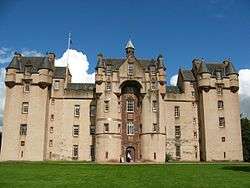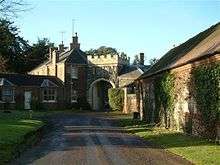Quadrangular castle
A quadrangular castle or courtyard castle is a type of castle characterised by ranges of buildings which are integral with the curtain walls, enclosing a central ward or quadrangle, and typically with angle towers. There is no keep and frequently no distinct gatehouse. The quadrangular form predominantly dates from the mid to late fourteenth century and signals the transition from defensively to domestically oriented great houses. The four walls are also known as ranges.
Quadrangular castles typically display a sophisticated and complex approach to the planning of internal social spaces.[1][2] There are many quadrangular castles around the UK, for example: Bodiam Castle in East Sussex, and Bolton Castle.
The 27 quadrangular castles identified by John Rickard as being built in England consist roughly 10% of the castles built in the country between 1272 and 1422. No castles of this design were built in Wales.[3]
One of the earliest quadrangular castles in Germany is Neuleiningen, of which substantial ruins remain.
List of quadrangular castles
| Name |
Location |
Coordinates |
Constructed |
Built for |
Designed by |
Significant events |
Heritage status |
Image |
|---|
| Beverston Castle |
Cotswold |
51°38′39″N 2°12′05″W / 51.6442°N 2.20139°W / 51.6442; -2.20139 |
1225 |
Maurice de Gaunt
Thomas de Berkeley, 3rd Baron Berkeley |
anonymous |
siege
conflagration |
Grade I listed building
scheduled monument |
|
| Bodiam Castle |
East Sussex |
51°00′08″N 0°32′37″E / 51.00226°N 0.54353°E / 51.00226; 0.54353 |
1385 |
Edward Dalyngrigge |
anonymous |
Licence to crenellate |
Grade I listed building
scheduled monument |
|
| Bolton Castle |
Richmondshire |
54°19′20″N 1°57′00″W / 54.3221°N 1.94991°W / 54.3221; -1.94991 |
1379 |
Richard le Scrope, 1st Baron Scrope of Bolton |
John Lewyn |
Slighting |
Grade I listed building
scheduled monument |
|
| Caverswall Castle |
Staffordshire Moorlands |
52°58′57″N 2°04′29″W / 52.9826°N 2.0746°W / 52.9826; -2.0746 |
1275 |
William de Caverswall |
anonymous |
Licence to crenellate |
Grade I listed building |
|
| Cawood Castle |
Selby |
53°49′53″N 1°07′40″W / 53.8313°N 1.1278°W / 53.8313; -1.1278
53°49′53″N 1°07′47″W / 53.8313°N 1.12974°W / 53.8313; -1.12974 |
1378 |
John Kemp |
anonymous |
Licence to crenellate |
Grade I listed building
scheduled monument |
|
| Chideock Castle |
West Dorset |
50°44′03″N 2°49′06″W / 50.7343°N 2.81825°W / 50.7343; -2.81825 |
1370s |
Sir John Chideock |
anonymous |
Licence to crenellate |
scheduled monument |
|
| Chillingham Castle |
Northumberland |
55°31′34″N 1°54′18″W / 55.526°N 1.905°W / 55.526; -1.905 |
1344 |
Sir Thomas Heton |
anonymous |
Licence to crenellate
siege |
Grade I listed building |
|
| Cooling Castle |
Medway |
51°27′20″N 0°31′22″E / 51.4555°N 0.522732°E / 51.4555; 0.522732 |
1380s |
John de Cobham, 3rd Baron Cobham |
Henry Yevele |
Licence to crenellate |
Grade I listed building
scheduled monument |
|
| Danby Castle |
North Yorkshire |
54°27′20″N 0°53′43″W / 54.4555°N 0.895197°W / 54.4555; -0.895197 |
1302 |
William Latimer, 1st Lord Latimer |
anonymous |
|
Grade I listed building
scheduled monument |
|
| Farleigh Hungerford Castle |
Mendip |
51°19′03″N 2°17′13″W / 51.3174°N 2.2869°W / 51.3174; -2.2869 |
1383 |
Thomas Hungerford |
anonymous |
Licence to crenellate |
Grade I listed building
scheduled monument |
|
| Ford Castle |
Northumberland |
55°37′53″N 2°05′25″W / 55.6314°N 2.09025°W / 55.6314; -2.09025 |
1338 |
Sir William Heron |
anonymous |
Licence to crenellate
military offensive
conflagration |
Grade I listed building |
|
| Fyvie Castle |
Aberdeenshire |
57°26′36″N 2°23′42″W / 57.4433°N 2.3949°W / 57.4433; -2.3949 |
1300s |
anonymous |
anonymous |
|
category A listed building |
|
| Greys Court |
South Oxfordshire |
51°32′42″N 0°57′22″W / 51.545°N 0.956164°W / 51.545; -0.956164 |
1348 |
John de Grey, 2nd Baron Grey de Rotherfield
Francis Knollys, 1st Viscount Knollys
Baron Lovel |
anonymous |
Licence to crenellate |
Grade I listed building
scheduled monument |
|
| Greystoke Castle |
Eden
Cumbria |
54°40′12″N 2°52′37″W / 54.66998°N 2.87705°W / 54.66998; -2.87705 |
1353 |
William de Greystoke, 2nd Baron Greystoke |
anonymous |
Licence to crenellate
conflagration |
Grade II* listed building |
|
| Hartley Castle |
Cumbria |
54°28′09″N 2°20′12″W / 54.4691°N 2.33655°W / 54.4691; -2.33655 |
1353 |
Thomas de Musgrave
Sir Richard Musgrave, 1st Baronet |
anonymous |
Licence to crenellate
demolition |
scheduled monument
Grade II listed building |
|
| Hemyock Castle |
Mid Devon |
50°54′45″N 3°13′54″W / 50.9125°N 3.23156°W / 50.9125; -3.23156 |
1380 |
William Asthorpe
Margaret Asthorpe |
anonymous |
Licence to crenellate |
scheduled monument
Grade II* listed building |
|
| Hever Castle |
Hever |
51°11′13″N 0°06′50″E / 51.186944°N 0.113889°E / 51.186944; 0.113889 |
1271 |
William de Hever |
anonymous |
Licence to crenellate |
Grade I listed building |
|
| Inverlochy Castle |
Highland |
56°49′57″N 5°04′52″W / 56.8326°N 5.081°W / 56.8326; -5.081 |
1270s |
Clan Cumming |
anonymous |
|
category B listed building |
|
| Lumley Castle |
County Durham |
54°51′17″N 1°33′11″W / 54.8547°N 1.55293°W / 54.8547; -1.55293 |
1389 |
Ralph de Lumley, 1st Baron Lumley |
John Lewyn
John Vanbrugh |
Licence to crenellate |
Grade I listed building |
|
| Maxstoke Castle |
Warwickshire |
52°29′58″N 1°40′18″W / 52.4994°N 1.67167°W / 52.4994; -1.67167 |
1345 |
William de Clinton, 1st Earl of Huntingdon |
anonymous |
Licence to crenellate |
Grade I listed building
scheduled monument |
|
| Moor End Castle |
Northamptonshire |
52°05′42″N 0°54′01″W / 52.0949°N 0.900155°W / 52.0949; -0.900155 |
1347 |
Edward III of England
Thomas de Ferrers |
anonymous |
Licence to crenellate |
scheduled monument |
|
| Raby Castle |
County Durham |
54°35′27″N 1°48′06″W / 54.59092°N 1.80175°W / 54.59092; -1.80175 |
1378 |
House of Neville |
John Lewyn |
Licence to crenellate |
Grade I listed building |
|
| Ravensworth Castle |
Tyne and Wear |
54°55′34″N 1°38′18″W / 54.9262°N 1.6384°W / 54.9262; -1.6384 |
1350s |
Marmaduke Lumley |
anonymous |
|
Grade II* listed building
scheduled monument |
|
| Sheriff Hutton Castle |
North Yorkshire
Ryedale |
54°05′17″N 1°00′19″W / 54.0881°N 1.00519°W / 54.0881; -1.00519 |
1382 |
John Neville, 3rd Baron Neville de Raby |
John Lewyn |
Licence to crenellate |
Grade II* listed building
scheduled monument |
|
| Shirburn Castle |
South Oxfordshire |
51°39′27″N 0°59′38″W / 51.6576°N 0.9938°W / 51.6576; -0.9938 |
1377 |
Warin de Lisle |
Henry Yevele
anonymous |
Licence to crenellate |
Grade I listed building |
|
| Somerton Castle |
North Kesteven |
53°07′03″N 0°34′34″W / 53.1174°N 0.57616°W / 53.1174; -0.57616 |
1281 |
Antony Bek |
anonymous |
Licence to crenellate |
Grade I listed building
scheduled monument |
|
| Starborough Castle |
Surrey |
51°10′42″N 0°02′19″E / 51.1783°N 0.0386396°E / 51.1783; 0.0386396 |
1341 |
Reginald de Cobham, 1st Baron Cobham |
anonymous |
Licence to crenellate
Slighting |
scheduled monument
Grade II* listed building |
|
| Westenhanger Castle |
Kent
Shepway |
51°05′40″N 1°01′53″E / 51.0944°N 1.03144°E / 51.0944; 1.03144 |
1343 |
John de Criol
Edward Poynings |
anonymous |
Licence to crenellate
military offensive
demolition |
scheduled monument
Grade I listed building |
|
| Wingfield Castle |
Mid Suffolk |
52°20′52″N 1°15′41″E / 52.3479°N 1.2614°E / 52.3479; 1.2614 |
1384 |
Michael de la Pole, 1st Earl of Suffolk |
anonymous |
Licence to crenellate |
Grade I listed building |
|
| Woodcroft Castle |
Cambridgeshire |
52°37′35″N 0°19′02″W / 52.6263°N 0.3172°W / 52.6263; -0.3172 |
1280 |
anonymous |
anonymous |
|
Grade II* listed building |
|
| Woodsford Castle |
West Dorset |
50°42′45″N 2°20′38″W / 50.7126°N 2.34389°W / 50.7126; -2.34389 |
1336 |
William de Whitefield
Guy de Bryan, 1st Baron Bryan |
anonymous |
Licence to crenellate |
Grade I listed building |
|
| Wressle Castle |
East Riding of Yorkshire |
53°46′32″N 0°55′45″W / 53.7755°N 0.929291°W / 53.7755; -0.929291 |
1390s |
Thomas Percy, 1st Earl of Worcester
Henry Percy, 5th Earl of Northumberland |
John Lewyn |
Slighting
archaeological field survey
conflagration |
Grade I listed building
scheduled monument |
|
References
- ↑ Faulkner, P (1958). "Domestic planning from the 12th to the 14th centuries". Archaeological Journal. 115: 150–83.
- ↑ Faulkner, P (1963). "Castle planning in the fourteenth century". Archaeological Journal. 120: 215–35.
- ↑ Rickard, John (2002). The castle community: the personnel of English and Welsh castles : 1272 - 1422 (1. publ. ed.). Woodbridge: Boydell. p. 21. ISBN 9780851159133.



























